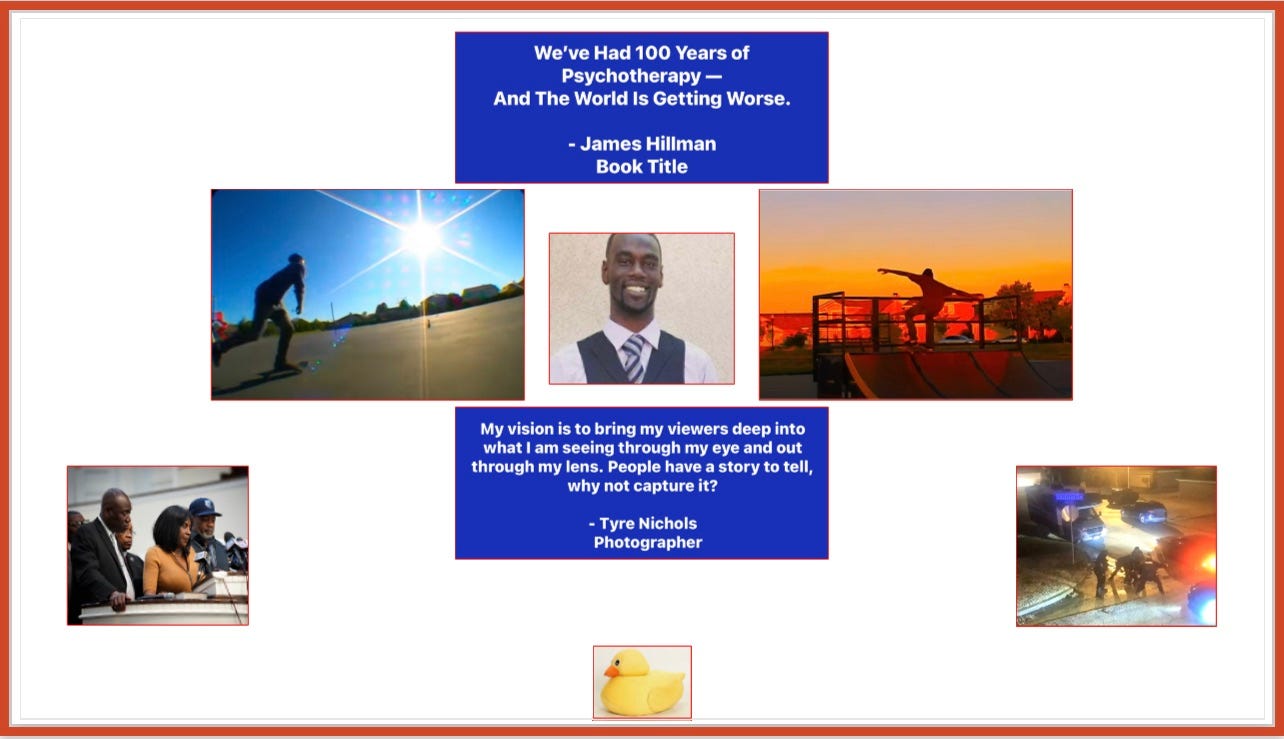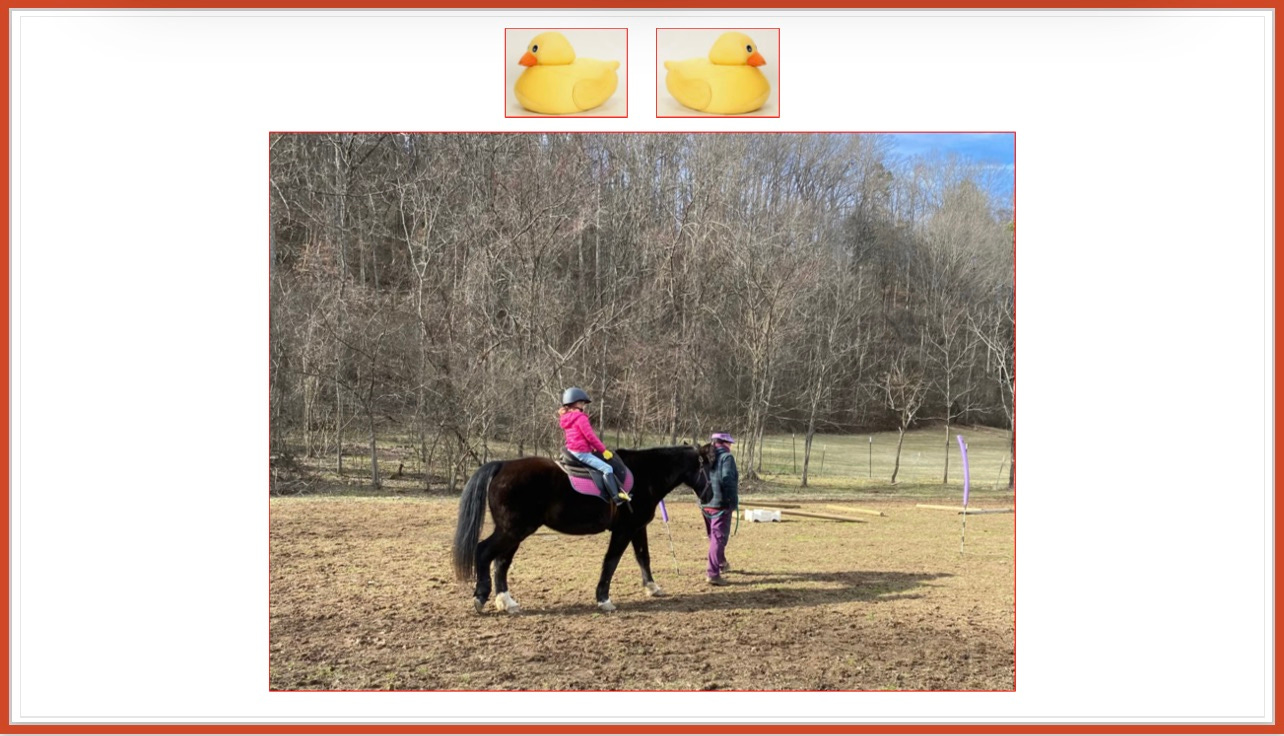Sunday-morning greetings from newShrink.
Since about late-news time Friday night I’ve been unable even to ponder writing and posting about anything or anyone but Tyre Nichols this weekend. Not leading with the primitive brutality by which he was killed by five Memphis police officers, the story pulling my attention is first Nichols’ — the 29-year-old as subject, not the object to which things were done. This is despite, or maybe even because of, the degree of horrifyingly graphic video detail and factual clarity we have of this widely witnessed killing.
Along with crisis level public-policy concerns there are many depth/soul psychological dimensions for consideration both with Nichols individually and the events and overarching issues around his death and policing in general.
Aside from the more complex matters of our psychodynamics, neurological and biological functioning are the fundamental soul elements of our capacity for basic humanity, empathy, decency. This week a good theme and stretch-goal might be defining how and when we individually and collectively might begin just to do a better job of being human.
Meanwhile, the planned (mostly finished) edition including introduction of a new Best Psychologists… (Who Aren’t) feature will appear soon. Perhaps it will incorporate or be informed by some of today’s focus.
Also in the post-midnight-hours after Friday night’s release of police video footage of the Nichols attack, I was glad to discover political-historian Heather Cox Richardson posting her Letters from an American with what sounds like her very similar response with her characteristic grace and lovely writing:
There is a great deal to say here, but everything I write seems to flatten Mr. Nichols’s life into the few minutes of brutal beating that led to his death.
It seems to me that I should stand aside tonight and let Mr. Nichols represent himself. (www.heathercoxrichardson.substack.com)
🔵
A Skateboarder… Fed Ex worker… Father of a 4-year-old… “Beautiful soul with creative eye”
A couple of more profile-focused stories, plus Nichols’ own voice and vision expressed online and creatively, take up the question, who was Tyre Nichols?
Tyre Nichols remembered as beautiful soul with creative eye (The Associated Press)
From Sacramento to Memphis, Tyre Nichols Cut His Own Path (Profile/The New York Times)
Among biographical details from the stories, Nichols had grown up in Sacramento with his biological father, experiencing his dad’s terminal illness and death as a teen. Several close friends, including a minister’s daughter from those years described him as a gentle, caring friend who stayed in touch and was involved with them in church and service activites. He was a joyous whiz at skateboarding, and was both concerned/critical of issues in policing as Black Lives Matter cases surfaced nationwide. He also had considered becoming a police officer himself, to try to seek change within the system.
In California Nichols fathered a son in a relationship that didn’t last, though his concern, support and desire to create a better life for him did. As Covid intensitified the financial challenges and high cost of living in California, Nichols moved east to Memphis, where he was very close with his mother and had lived in recent years with her and his stepfather (pictured together at left above).
His stepfather, also a Fed Ex employee, had helped Nichols get one of the highly desired jobs there, and Tyre worked the evening shift. Nichols was on his way home, only some 100 feet from getting there, the night he was beaten and killed.
Tyree was 6 feet 3” but weighed only 145, his slight build a side-effect of the Crohn’s disease from which he suffered.
For me a moving discovery about Nichols was his photography work (described in the quote pictured at center above). Both his stated passion and intention, and the creative self-expression of his website (pictured next) speak to newShrink’s depth-psychology emphasis on increasing connection with authentic Self and voice and the role of personal story in our individuation.
Nichols’ website quotes a favorite photographer, Joel Sasser, about the work for which he had such passion:
A good photographer must love life more than photography itself.
This California Kid2
Here are his full comments, from the AP profile:
On most weekends, Tyre Nichols would head to the city park, train his camera on the sky and wait for the sun to set.
“Photography helps me look at the world in a more creative way. It expresses me in ways I cannot write down for people,” he wrote on his website. He preferred landscapes and loved the glow of sunsets most, his family has said.
“My vision is to bring my viewers deep into what I am seeing through my eye and out through my lens,” Nichols wrote. “People have a story to tell, why not capture it?”
(Here is the full name of the website link: https://thiscaliforniakid2.wixsite.com/tnicholsphotography)
Given the rather accidental evolution of newShrink’s photo-collage illustrations (described in 12.11.22 White Space, White Noise… and a Sampler Box of News ) it was a heartwarming surprise for me to open this young man’s photo-collage website. His effect and process are so similar — yet his is with his own carefully envisioned photographs, and such superior ones!
Nichols’ creative photography work apparently was similarly moving to Heather Cox Richardson, whose brief post shared the website. This is not surprising, as Richardson just recently married her longtime partner Buddy Poland, a lobsterman and photographer whose beautiful work she periodically shares with her thousands of readers.
🔵
Here now are stories covering developments in the case from the traffic stop and beating through Nichols’ death and aftermath.
“The definition of excessive force” (Policing experts in The New York Times)
Video Captures Brutal Beating of Tyre Nichols (The New York Times)
Video and text included in embedded links.
The footage shows the Memphis police kicking, punching and using a baton on the 29-year-old Black man, who died days later. Five officers were fired and charged with murder.
Linked threads and quotes provide graphic specifics and analysis from The Times.
Tyre Nichols video: What the footage of police beating shows (BBC.com news)
SCORPION Memphis special police unit accused in Tyre Nichols’ death faces scrutiny (CNN)
According to news reports late Saturday, Memphis police have permanenty disbanded the SCORPION unit.
Calls for police reform after Tyre Nichols' killing (NPR, Friday afternoon January 27)
All Things Considered host Ari Shapiro interviews Phillip Atiba Goff, CEO of the national Center for Policing Equity, about how the death of Tyre Nichols in Memphis speaks to larger issues with police department culture and diversity. At Yale Goff is a psychology professor and chair of African American Studies. I quote the proposed solutions extensively here, both because they represent psychologically sound practices — and also because they are data-based, rational and collaborative in approach.
Journalistic-kudos to Shapiro for leading directly with the elephant-in-the-room question, about a black-on-black police killing, in this case. And to Goff for answering with candor, facts and clear grasp of the complexity of overlapping issues here.
SHAPIRO: There's a widespread belief that if you have a police force that looks like the population of a community, that will reduce violence. In this instance, the five former officers charged with murder are all Black. So was the victim. And so what does the research say? Does diversity make a difference in police violence?
GOFF: So prior to 2021, I would have said that there's not strong evidence one way or the other. And my mind got changed by a piece of science by Bocar Ba that looked at data in Chicago that were just stronger data than any other place that we've had - did an apples-to-apples comparison and showed that Black officers and women officers of any race were far less likely to use force than were white male officers. That tells me that there is some benefit that's possible in diversifying police. But I want to be really clear - it is not the No. 1 suggestion, the No. 2, the No. 3. It doesn't rate in the top 10 of things that I would tell a police department to do.
So what’s #1? Goff says, maximize police effectiveness by using police for less — ie for fewer roles and functions best and far more safely performed by other trained professionals,
Give police more tools so that, when they are not the right tool, they can lean on them. So for instance, I would tell you, if someone's in a mental health crisis, send a social worker. Send a mental health professional.
And in some cases success is through changes in technology and procedure. For example:
SHAPIRO: In the specific instance of Tyre Nichols, he's stopped for a traffic violation, allegedly. What could have gone differently there?
GOFF: I'll tell you that, in Ithaca - in Tompkins County, N.Y., in Saint Louis, Mo., in Berkeley, Calif., we're very happy to have encouraged local leaders to end low-level traffic enforcement by law enforcement and to stop sending police when there's a nonfatal accident. It turns out, when you do that, you can just send the ticket via mail. Not introducing a badge and a gun to those situations does not mean we cannot enforce the rules. It does not mean that we're going to see more traffic accidents. And in fact, it's going to inspire more trust in those same systems 'cause they're going to end with fewer unnecessary deadly elements.
A few thoughts from a depth psychology perspective…
🌀Regarding the in search of some soul in the title, the entire Nichols story is poignant reminder, that whether we face and attend-to — or avoid and ignore — the soul or unconscious elements of ourselves, lives, situations, it is neither all-bad/evil nor all-good/virtuous. The soul, unconscious shadow, unexplored or ignored is just unknown, therefore out of our conscious control… and as such, often immensely, destructively powerful.
🌀I love an observation from Jungian Marie-Louise von Franz, regarding why it is good, desirable, even vital to “go-there” with things that are painful, difficult to feel, experience or face. She explains that, anything we can name “out-loud,” give narrative voice to/a “place in the story” no longer drives, controls, stifles or stuffs big parts of ourselves… or springs to destructive action beyond our control or imagining. For von Franz, anything — even the most painful, shameful of things — we can name, we can talk to, negotiate with, have a relationship with. It isn’t oneself, but rather something separate with which making conscious choices is then possible. (This, by the way, is a fundamental rationale for and the way that so-called talk therapies work.)
🌀Following this idea, from a psychological standpoint it is quite likely that the five officers fired and charged — and the several others passively at the scene taking no remedial action — in the Nichols killing had, and have, no conscious idea what “got into them.” They likely do not know what conscious thoughts and unconscious impulses, triggering images or symbols combined in such a deadly way both to impel such horrific intentional actions and inhibit positive, life-saving, life-serving ones.
🌀For just one example, neither the officers, nor the policing systems in which they and others across the nation operate, has a language or way of operating that recognizes, names or takes into account such potent unconscious forces as the power, particularly within a group, of archetypal/universal symbols — such as all of the trappings and ritual of trained Warriors on the hunt for Enemy/Evildoers or Elusive Prey.
🌀Even at the largely conscious, quantitative data-driven level, when we go in search of something we expect, hope to, and will be rewarded for finding (as with a criminal-revealing traffic stop), we tend not only to find more of it but also to keep looking for that and not notice other things. (This, by the way, also happens with very reputabole quantitative research that may turn up many cures for disease and other fine outcomes. But by definition valuing only what is measured, it’s also limited in that it goes in search of, even defining reality as, only what is measurable.)
🌀Also worth examining are neurological elements, what’s going on in the brain and nervous system of these officers — and the motorists-turned-suspects they pursue. These are largely unconscious, physiological responses for which there are very effective ways to intervene intentionally (eg. by changing one’s breathing patterns, ensuring slowed heart rate when crisis-decision-making is required.) When both police and “suspect”/motorist are functioning in high-reactivity, fight-flight-freeze mode, rational-brain decision-making is shut down as biological survival kicks in.
🌀One last note regarding this case is about the sheer physicality of the officers versus this “impossibly slight,” as one journalist described the 6’3”, 145-pound Nichols — a sufferer of Crohn’s disease. There’s a very animalistic, wild-dog-pack bullying quality, predatory dominance over fragile/weakened prey to the long minutes of video. It’s another, sobering reminder of our very human — and universal — instinctual, animal, nature of our unconscious soul. As Jung notes, by nature we are both instinctual/embodied and archetypal/spiritual (inspired by symbol.)
🔵
To move toward closing on a needed note of hope, here is a Saturday post from friend and a fellow former Observer newspaper journalist John Michael Cleghorn. Since 2008 John has been pastor of Caldwell Presbyterian Church, a diverse progressive missional congregation in Charlotte’s Elizabeth neighborhood. (Here his quote references another story from this week’s news, the Carolina Panthers’ late-week, in many ways controversial and unpopular head-coach hire with racial-inequity overtones.)
NOT DEFEATED
I admired coach Steve Wilks’ statement after earning but being passed over for the Panthers job. (Another wrong [Owner David] Tepper move.)
Whether it’s the worst elements of police culture or other structural barriers, he says it all:
“The sun rose this morning and by grace of God so did I,” Wilks said in a screen-grabbed message posted to Twitter. “I’m disappointed but not defeated. Many people arent built for this but I know what it means to persevere and see it through.”
🔵
Now I leave you today with an explanation of that little cameo ducky in the illustration up in today’s lede. Its message here is how, just maybe sometimes soul rides in unsuspected… on little duck feet.
Here granddaughter Miz E is mastering her fine new passion, I think with Count or Chief in this shot. Her weekly lessons are at a very hands-on-skills stable with a lifelong owner professional. Before and after each ride she is grooming, preparing, brushing and forming close physical and relational connection with the horses.
As for the duckies, if you zoom you can see she’s holding a bean-bag duck on each foot as she rides. They’re to remind and train her to always keep her heels down in the stirrups.
Such a sweetly simple way to make sure we stay on the horse, feet in the stirrups and moving where we want to go. Got any ducks?
And, that is all I have! Talk to you next week.
🦋💙 tish
… it is important that awake people be awake,
or a breaking line may discourage them back to sleep;
the signals we give — yes or no, or maybe —
should be clear: the darkness around us is deep.
— William Stafford, “A Ritual to Read to Each Other”
🔵








Well done. Thank you for this thoughtful piece.